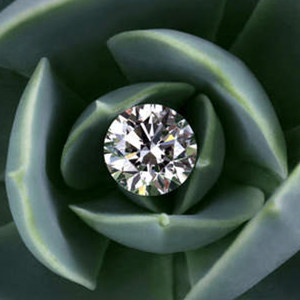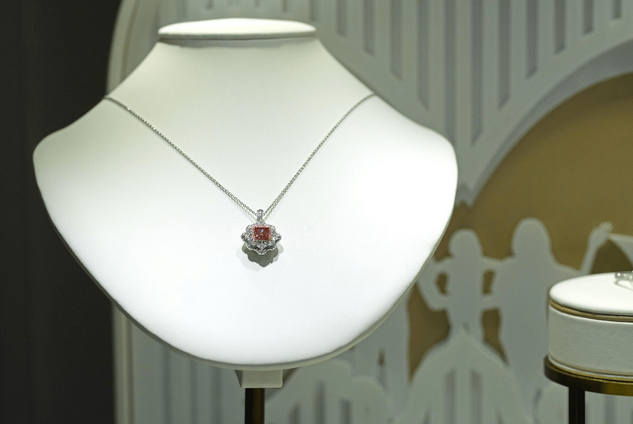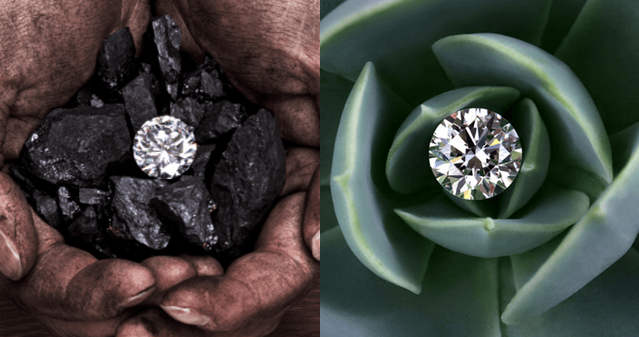
¥100,000 per carat high quality white diamond sells for ¥30,000, a rare pink diamond sells for ¥100,000 at the auction house for ¥4,000,000. It's not a fake, it's not fishy, it's identical, it's probably cleaner, but it's man-made, so do you buy it?
Many people are hesitant to buy them, especially jewellers who have been trading in natural diamonds for some time. Recently, however, jewellers and consumers worldwide seem to be moving towards a consensus that lab diamonds smell good.
Unlike zircon or moissanite, which have been labelled as fake or imitation diamonds, lab diamonds are identical to natural mineral diamonds in terms of physical, chemical and, most importantly for jewellery, optical properties.
Lab diamonds have also been referred to as synthetic diamonds, man-made diamonds, artificial diamonds, etc. over the years, but the name cultivated diamond was finally settled on because in 2018 the Federal Trade Commission (FTC) changed the definition of a diamond to remove the word 'natural' and classify both natural and lab grown diamonds as diamonds The FTC also concluded that such artificially created diamonds that look exactly like natural diamonds should not be called synthetic diamonds, and that Lab Grown Diamond is a more accurate and widely accepted term.
This year, China's National Jewellery and Jade Quality Supervision and Inspection Centre (NGTC) also launched the first 'Grown Diamond Certificates', officially endorsing the designation. In doing so, the Chinese regulator has perhaps seen the rise of lab diamonds in the domestic consumer market and the commercial value of China in the global cultivated diamond market, in addition to being in line with international practice.

Perhaps a better diamond
The production of natural diamonds is a far cry from 'beauty', as it destroys the surface ecosystem, consumes a lot of energy, and in some African mines can involve child labour, armed conflict and more. Leonardo's hit film "Blood Diamond" has made it even more difficult to remove the label of natural diamonds. The fact that everything that goes into cultivating a diamond takes place in a laboratory makes it even more 'beautiful' in terms of energy consumption, carbon emissions, sustainability and labour protection.
There are currently two production methods used worldwide, one is High Temperature and High Pressure (HPHT), which simulates an underground environment, and the other is Chemical Vapour Deposition (CVD), which is commonly used in the semiconductor industry to produce thin films. There is no difference between the products produced by the two methods. According to a report by Bain & Company, the two methods together currently reach an annual production of approximately 7 million carats. This compares to a global production of over 130 million carats of natural diamonds.
With such a large market space, what is most exciting for the country is China's position in cultivating the diamond industry chain. In the natural diamond sector, almost all natural diamonds bought by consumers in China are sourced from overseas as there are no sizeable gem-quality natural diamond mines in the country. Today, nearly half of the production capacity for HPHT lab diamonds is in China, and chemical vapour deposition (CVD) cultivated diamond manufacturing companies have sprung up.
Several listed companies have made a fortune, and Yellow River Cyclone has even made a splash this year with a seven-day, five-stop performance. The supply capacity at the production end is much smaller than the surging demand from overseas markets, creating a window of short-term windfall profits, but as manufacturers invest more, the balance of supply and demand for jewellery-grade lab diamonds will sooner or later be restored. If China's diamond industry wants to avoid falling into the fate of the smile curve of the shoe industry back then (do the most work, get the least money), long-term development will still have to rely on the consumer end of the brand.

lab diamonds from being boycotted to being integrated into the jewellery industry
Metal detectors cannot detect diamonds hidden in pockets, and in the jewellery industry, where a staggering fortune can be rolled up in passing, credibility is paramount. Small and medium-sized enterprises are often family-owned and bound by blood to trust, and any word of mouth from business people in the chain will quickly spread up and down the chain. This has also resulted in a relatively conservative and closed jewellery circle. According to jewellery industry insiders, jewellers used to avoid lab diamonds like the beast they are - no one wants to be told that they are "selling fakes" by their peers.
However, with a price difference of over 50% between the wholesale price of lab diamonds and natural diamonds, the temptation was always there for someone to take the risk, and before 2018 there were vicious incidents in Hong Kong and Macau where lab diamonds were exchanged for cash at pawnshops for natural diamonds, and some of the people involved were dealt with according to the law, but similar incidents have intensified the resistance to lab diamonds in the jewellery industry.
According to Guo Sheng, founder of CARAXY, the first domestic brand to enter the cultivated diamond market, when they exhibited lab diamonds at jewellery exhibitions around the world during 2015-2016, jewellers were generally very cautious, with some willing to try but unwilling to reveal their personal information and company information, and some customers even doubting the legality of selling such goods. "It felt like we were risking the industry to promote lab diamonds," Guo Sheng lamented, "The 2016 China International Diamond Industry Summit was the first high-profile industry dialogue between natural and lab diamonds in China, and we were promoting the harmonious co-existence of cultivated and natural diamonds. We were promoting the harmonious co-existence of cultivated and natural diamonds.
But that's changed recently
In 2018, De Beers launched its own high-profile cultivated diamond brand, LIGHTBOX, which sells fashion jewellery with lab diamonds as the main stone and does not classify diamonds according to the 4Cs, bringing an explosion of news and talk to the global diamond industry. According to several industry insiders, De Beers found that it was better to "block than to unblock" lab diamonds, and wanted to use its capital advantage to use a low-price strategy to steer the global cultivated diamond market towards cheap fashion jewellery, and to differentiate it from its own core business of mainly emotional and rare and precious natural diamonds.
Three years on, however, De Beers' low-price strategy has not worked, but has instead given the jewellery industry and consumers enormous confidence, leading to a continued acceleration in demand for gra diamond in both the to B and to C markets in Europe and the US. As recently as 30 August this year, De Beers further announced that Lightbox would launch a high-end product line, selecting high-quality products graded according to natural diamonds, with a carat of loose diamonds priced in the tens of thousands of RMB and a matching ring, making a grand entrance into the diamond industry's own territory.
This is true of the giants, but even more so of the lighter luxury brands. Despite the fact that, due to their lower pricing, they themselves rarely use materials such as diamonds. Still, jewellery giant Pandora has made its attitude clear. In June this year it announced that in future it would stop using natural diamonds forever and that only lab diamonds would be used in diamond materials. Other well-known brands such as Swarovski and Chanel have also started investing in the cultivated diamond sector.
This is despite the fact that luxury diamond are rarely used as a material themselves due to their lower pricing. Nevertheless, the jewellery giant Pandora has made its attitude clear. In June this year it announced that in future it would stop using natural diamonds forever and that only lab diamonds would be used for diamond materials. Other well-known brands such as Swarovski and Chanel have also started investing in the cultivated diamond sector.
On 8 September, at the China Gold & Jewellery Gala and the celebration of 30 years of China Gold Newspaper, the award was presented on the same stage as the "30 Years of China's Gold & Jewellery Industry" to young entrepreneurs recognised in the industry, among whom were lab diamonds. Among them was Guo Sheng, the founder of Man Made Diamonds. Some of the largest companies in China have also spotted the business opportunities, with listed companies such as Yuyuan Jewellery and Walden already launching their own lab diamond brands this year.
And with such opportunities in the diamond industry, competition is becoming increasingly global. It is reported that the American cultivated diamond brand Diamond Foundry and the French Courbet have already entered the Chinese market, while the domestic brand CARAXY Kailash also has plans to enter overseas and join the international arena of competition.

The future of diamonds and the brands of the future
Diamonds can go beyond simple material pricing, apart from its sparkle and glamour, or because it is bound to love. For lab diamonds to have a future, it ultimately needs its unique emotional value, sustainability, a modern outlook on love and consumption, all elements of the new generation of consumers that are difficult to give to natural diamonds, and perhaps this is why De Beers is finally letting lab diamonds onto its turf. No one wants to win the game and lose the future.
Thomas Edison once said "There are two things that I cannot make in my laboratory: pearls and diamonds". Now his dream has been realised. The pearls on the market are now almost entirely cultured, and Mikimoto, the top pearl brand in the minds of consumers, is not the guardian of natural pearls but the inventor of cultured pearls. And what about diamonds?













